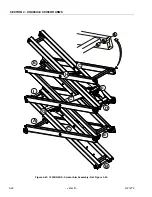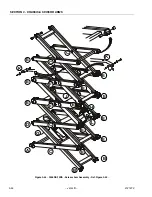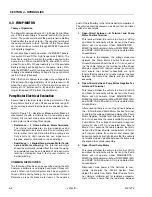
SECTION 4 - HYDRAULICS
3121273
– JLG Lift –
4-1
SECTION 4. HYDRAULICS
4.1 CYLINDERS - THEORY OF OPERATION
Cylinders are of the double acting type. The Lift and Steer
systems incorporate double acting cylinders. A double
acting cylinder is one that requires oil flow to operate the
cylinder rod in both directions. Directing oil (by actuating
the corresponding control valve to the piston side of the
cylinder) forces the piston to travel toward the rod end of
the barrel, extending the cylinder rod (piston attached to
rod). When the oil flow is stopped, movement of the rod
will stop. By directing oil to the rod side of the cylinder, the
piston will be forced in the opposite direction and the cyl-
inder rod will retract.
NOTE:
The lift cylinder is a single acting cylinder which takes
hydraulic pressure to extend and gravity to retract.
A holding valve is used in the hydraulic lift circuit to pre-
vent motion unintended by the operator in the event of a
hydraulic line failure.
4.2 VALVES - THEORY OF OPERATION
Solenoid Control Valves (Bang-Bang)
Control valves used are four-way, three-position solenoid
valves of the sliding spool design. When a circuit is acti-
vated and the control valve solenoid energizes, the spool
is shifted and the corresponding work port opens to per-
mit oil flow to the component in the selected circuit, with
the opposite work port opening to reservoir. Once the cir-
cuit is deactivated (control returned to neutral), the valve
spool returns to neutral (center) and oil flow is then
directed through the valve body and returns to reservoir. A
typical control valve consists of the valve body, sliding
spool, and two solenoid assemblies. The spool is
machine fitted in the bore of the valve body. Lands on the
spool divide the bore into various chambers, which, when
the spool is shifted, align with corresponding ports in the
valve body open to common flow. At the same time other
ports would be blocked to flow. The spool is spring-
loaded to center position, therefore when the control is
released, the spool automatically returns to neutral, pro-
hibiting any flow through the circuit.
Relief Valves
Main relief valves are installed at various points within the
hydraulic system to protect associated systems and com-
ponents against excessive pressure. Excessive pressure
can be developed when a cylinder reaches its limit of
travel and the flow of pressurized fluid continues from the
system control. The relief valve provides an alternate path
for the continuing flow from the pump, thus preventing
rupture of the cylinder, hydraulic line or fitting. Complete
failure of the system pump is also avoided by relieving cir-
cuit pressure. The relief valve is installed in the circuit
between the pump outlet (pressure line) and the cylinder
of the circuit, generally as an integral part of the system
valve bank. Relief pressures are set slightly higher than
the load requirement, with the valve diverting excess
pump delivery back to the reservoir when operating pres-
sure of the component is reached.
Crossover Relief Valves
Crossover relief valves are used in circuits where the actu-
ator requires an operating pressure lower than that sup-
plied to the system. When the circuit is activated and the
required pressure at the actuator is developed, the cross-
over relief diverts excess pump flow to the reservoir. Indi-
vidual, integral relief’s are provided for each side of the
circuit.
Proportional Valve
Flow is proportional to the amount of voltage supplied to
the valve coil. Voltage is gained by the machine controller
and determined by the position of the joystick.
Manual Descent Valve
The manual descent valve is located on the top of the
holding valve on the lift cylinder. The holding valve is a
normally closed solenoid valve, and holds the platform in
place when raised. When activated, the valve opens to
permit lift down. The holding valve is connected to the
manual descent valve, which is connected to a cable
which, when pulled, manually opens the lift down port of
the valve and allows the platform to be lowered in the
event hydraulic and/or electric power is lost.
Содержание 1932RS
Страница 1: ...Service Maintenance Manual Models 1932RS 6RS 3248RS 10RS 3121273 April 8 2013...
Страница 2: ......
Страница 12: ...viii JLG Lift 3121273 TABLE OF CONTENTS NOTES...
Страница 69: ...SECTION 3 CHASSIS SCISSOR ARMS 3121273 JLG Lift 3 37 NOTES...
Страница 73: ...SECTION 3 CHASSIS SCISSOR ARMS 3121273 JLG Lift 3 41 Figure 3 41 Arms and Platform Positioning and Support...






































